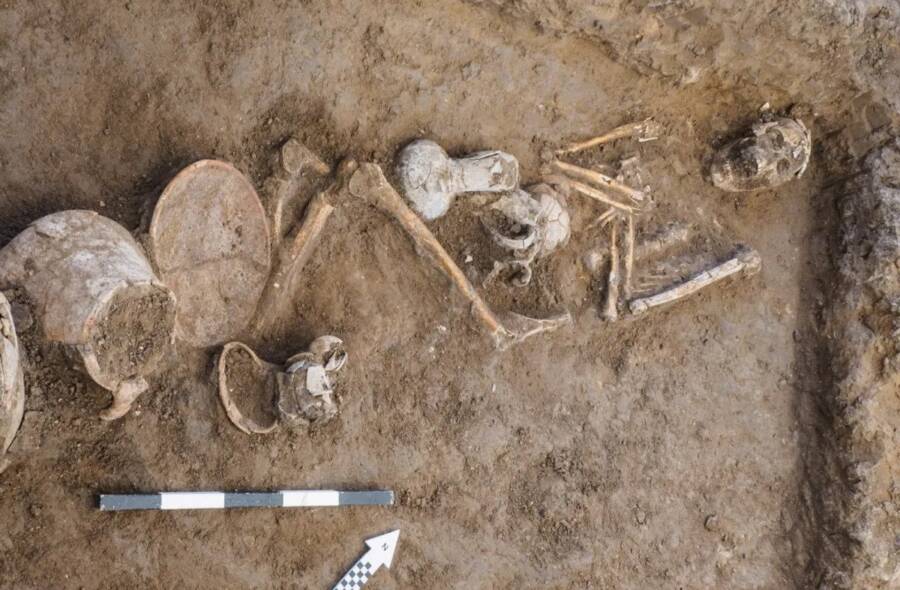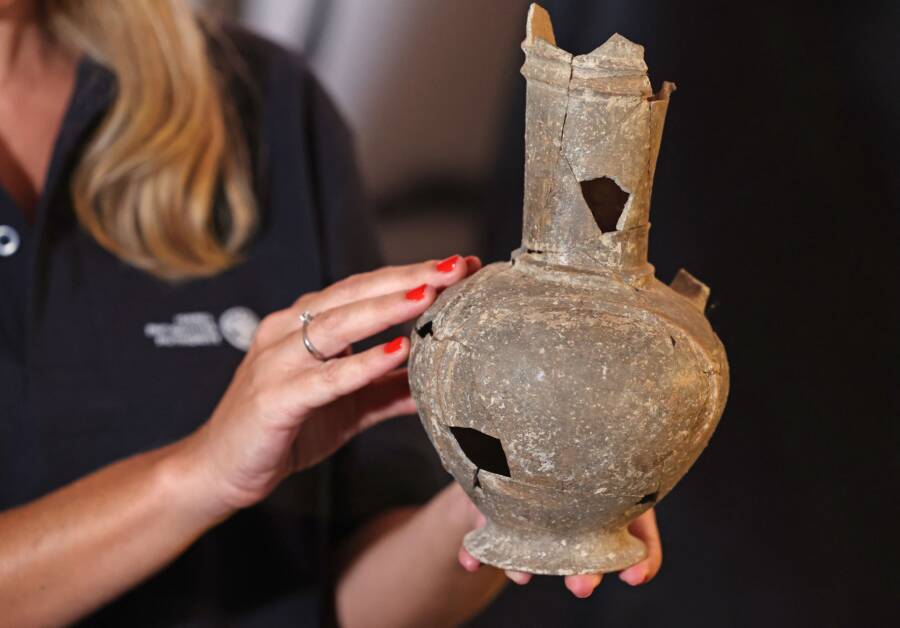Experts suspect that ancient people in Israel used opium to enter an "ecstatic state" during a loved one's funeral.

Assaf Peretz/ Israel Antiquities Authority.This skeleton was buried with pottery vessels containing opium more than 3,000 years ago.
While excavating a site in Yehud, Israel, archaeologists with the Israel Antiquities Authority (IAA) discovered several late Bronze-Age skeletons that had been buried with pottery vessels shaped like poppy flowers. Now, in association with the Weizmann Institute of Science, they’ve determined that the vessels contained traces of opium.
“This is the first empirical physical evidence of the use of opium in the Levant in the Late Bronze Age,” Vanessa Linares, the lead author of a new study on the pottery vessels, told The Times of Israel. “This is the first identifiable without-a-shadow-of-a-doubt opium use in the Levant — and I would say even in the Old World.”
As IFLScience reports, IAA archaeologists began excavating the site in Yehud in 2012. They came across several ancient skeletons who lived in the area when it was called Canaan, as well as animal bones and a number of 3,400-year-old pottery vessels. Because the pottery vessels were shaped like poppies, from which opium is derived, the archaeologists suspected that ancient people used the vessels to store the drug.
But it wasn’t until a recent examination of the vessels that the archaeologists’ suspicions were confirmed: The vessels did, indeed, contain traces of opium.

Assaf Peretz/Israel Antiquities AuthorityThe vessels were shaped like poppies, leading the archaeologists to suspect that they could contain opium.
So how did ancient people use opium in their funerary rites? Experts aren’t entirely sure.
“Of course, we do not know what the opium’s role was in the ceremony – whether the Canaanites in Yehud believed that the dead would need opium in the afterlife, or whether it was the priests who consumed the drug for the purposes of the ceremony,” Linares explained to IFLScience.
But Ron Be’eri, an IAA archaeologist, noted that some ancient texts hint at how ancient people might have used opium.
“From documents that were discovered in the Ancient Near East, it appears that the Canaanites attached great importance to ‘satisfying the needs of the dead’ through ritual ceremonies performed for them by the living, and believed that in return, the spirits would ensure the health and safety of their living relatives,” he told the publication.
To the BBC, Be’eri added: “It may be that during these ceremonies, conducted by family members or by a priest on their behalf, participants attempted to raise the spirits of their dead relatives in order to express a request, and would enter an ecstatic state by using opium.”
He continued by saying it was also possible that ancient people placed opium in a grave in hopes of helping “the person’s spirit rise from the grave in preparation for the meeting with their relatives in the next life” but acknowledged that ancient peoples’ use of opium remains speculative.

AHMAD GHARABLI/AFP via Getty ImagesOne of the 3,400-year-old vessels that contained opium.
Finding the first evidence of opium use is certainly significant. But the discovery also offers a fascinating peek into the ancient opium trade.
According to the BBC, the pottery vessels that contained the drugs are called Base-Ring juglets. They were not made in Israel, but in Cyprus, and apparently brought to the country for funerary purposes. Likewise, the opium itself was sourced from Turkey, where the poppy flower grows in abundance.
“In other words, the opium was brought to Yehud from Turkey, through Cyprus; this of course indicates the importance that was attributed to the drug,” Linares told IFLScience.
The idea to use opium during funerary rites may have been imported as well. As the Times of Israel reports, Egyptian ideas heavily influenced Canaanite culture, thanks to Egyptian invasions in the 14th and 13th centuries B.C.E.
That said, it’s certainly possible that ancient people in Israel used opium for more than just burials. To the Times of Israel, Linares guessed that its use could have been more widespread in Canaanite culture.
“Perhaps when we excavate more, we’ll find juglets and residue of it in houses,” she said.
After reading about the earliest known opium use discovered in Israel, see how Israeli archaeologists came across an incredible prehistoric elephant tusk. Or, learn about the ancient “swearing bowls” that archaeologists found in Israel that may have once been used to repel demons.





